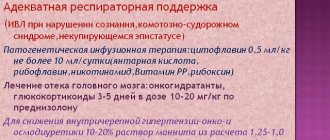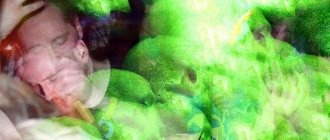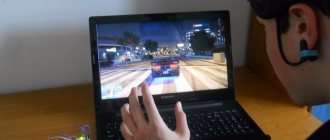In psychiatry and neurology, the term normal functioning of consciousness refers to the physically healthy state of a mentally adequate person who is awake. Unimpaired clear consciousness implies the presence in the individual of the ability to fully perceive stimuli emanating from the external environment and correctly interpret them. Unchanged consciousness characterizes the subject’s ability to fully navigate in space, time and his own personality. The normal function of consciousness allows you to fully realize the existing intellectual potential, use all available cognitive abilities and fully use the mnestic function (memory).
Disturbances of consciousness are various disruptions in the physiological status of the body and disorders of higher mental functions, in which the perception of stimuli and the demonstration of behavior do not correspond to the existing situation and do not meet the criteria of the norm. Disorders of consciousness can be either short-lived or observed over a long period of time. Lack of clear consciousness can also be mild (superficial) or severe (deep).
From a modern point of view, all types of consciousness disorders can be conditionally divided into several groups.
Group one. Quantitative violations
Quantitative disorders imply a certain degree of severity (depth) of a disruption in the mental and physical functioning of the body. In this case, the most severe deviation may be preceded by less serious types of violations. The following types of disorder are present in this group:
- obtundation syndrome, also called deafening;
- sopor;
- coma.
Stunned consciousness syndrome
Stunning is most often the initial stage of complete loss of consciousness. If untimely and improperly treated, the disorder can lead to stupor and coma.
The leading symptom of stunning is a significant increase in the level of perception of all environmental stimuli. A characteristic feature of the syndrome is the impoverishment of the individual’s mental activity. The person is in a drowsy state. Sometimes there may be bursts of mental activity. Human facial expressions become poorer. The patient is lethargic and passive, he gets tired very quickly.
The ability to navigate in space and time deteriorates. The perception of one’s own “I” does not undergo changes. While speech contact is fully preserved, the patient has difficulty understanding the questions addressed to him. He gives an answer, usually unambiguous, some time after hearing the question. Often additional stimulation is required in the form of calling the patient by name.
A subtype of deafening syndrome is obnubilation, a mild degree of disorder whose symptoms resemble alcohol intoxication. The patient indicates that his consciousness is “clouded” and he perceives reality through a veil. In this state, a person becomes distracted and inattentive, and through efforts of will he tries to connect with reality.
Another type of stupor is somolentity, a state similar to the period between sleep and wakefulness. While half asleep, the individual demonstrates minimal activity. The patient lies motionless with his eyes closed. With this disorder of consciousness, the patient is able to give correct answers to simple questions, but he does not understand more complex requests.
Treatment of stunned consciousness syndrome is aimed at eliminating the symptoms of the underlying somatic disease, since the causes of this disorder are endogenous intoxications.
Sopor
Stupor is a pathological condition in which there are no adequate reactions of the body to presented stimuli. With this type of disorder, the patient can be returned to clear consciousness only with intense repeated stimulation, and the return to normal status occurs for a short period of time. Unlike a coma, with stupor a complete loss of consciousness is not recorded. Most doctors interpret stupor as a condition immediately preceding coma.
The main symptoms of stupor are significant depression of mental functions, significant inhibition of activity. The patient loses the ability to perform voluntary movements. However, the preservation of the reflex response is recorded if it is presented with a strong stimulus. The patient is able to carry out automatic stereotypic motor activity. The fact that a person perceives painful stimuli is indicated by corresponding changes in facial expressions and the performance of protective movements. This is evidenced by a person’s production of sound signals indicating the perception of pain.
Coma
Coma is a state of complete lack of reactivity. A distinctive feature of coma is the inability to return the patient to clear consciousness even through the use of intense repeated stimulation. With this disorder, it is not possible to detect the slightest signs of functioning of the mental sphere.
The main sign of a coma is the absence of a primitive reflex response when exposed to strong stimuli. However, with moderate severity of disorders, a response to painful stimuli is determined in the form of flexion and extension simple motor acts. With a deep degree of severity of the disorder, various changes in the tone of the skeletal muscles are recorded. The terminal stage is characterized by critical values of blood pressure or these indicators are not determined at all. Severe disruptions in cardiac activity in the form of heart rhythm disturbances are observed.
Treatment of coma is selected after a neurological examination and assessment of the patient's condition. Prediction of coma is one of the most difficult tasks in neurological practice. The only reasonable criterion for excluding the possibility of a patient’s recovery is the recording of brain death. In other situations, especially if the victims are children or young people, recovery is possible even when showing threatening indicators.
Group two. Qualitative violations
Qualitative disorders indicate what specific malfunction occurred in the physical and mental state of the body. Despite the existence of various types of disorders, almost all qualitative disorders of consciousness correspond to the following characteristics:
- detachment of the patient from the environment;
- inability to adequately perceive reality;
- disorientation in space, time, surrounding persons, one’s own personality;
- deterioration in the quality of thinking, its incoherence and illogicality;
- complete or partial loss of memory for events that occurred during stupefaction.
This group of consciousness disorders includes the following types.
Delirium
Viral encephalitis
Viral encephalitis in children and adults can be of a primary nature, in which inflammatory damage to the brain and meninges is provoked by infection with a neurotropic virus (acting on the central nervous system and penetrating the blood-brain barrier). Also, a viral disease can be a secondary condition, arising as a complication of another infectious process. Viral encephalitis of the brain differs in its etiology (pathogen), [...]
It is very important to provide first aid to the injured person correctly. In such cases, it is important to answer the following questions: is the victim breathing normally, is the heart beating, is there blood circulation, is consciousness impaired. The question of whether the victim is conscious or not is extremely important, since by answering it, one can obtain information about the state of the victim’s brain. For the implementation of conscious activity, the network formation is very important. The reticular formation is a collection of a special kind of nerve cells and their processes located in the central parts of the brain stem. This formation stimulates the function of the cerebral cortex; during sleep, its activity weakens.
If a child faints
If a child faints, then, first of all, lay him down properly and start spraying him with cold water.
After this, take the cologne and rub it on his arms, chest, back and legs. If this procedure does not help, resort to ammonia. Be extremely careful, since ammonia, or rather its prolonged inhalation, can cause temporary paralysis of the child’s vasomotor center. Moisten a cotton swab with ammonia and hold it to the child’s nose for about twenty to thirty seconds. If necessary, you can repeat this procedure, but only after two minutes. And so on until the child regains consciousness. In case of deep fainting, both adults and children can be given artificial respiration. As soon as the person regains consciousness, give him strong, hot tea. It is also very important that after loss of consciousness the patient is provided with complete rest. By the way, if you have any illness and you know that you can faint at any moment, do not “wait for weather by the sea.”
Buy yourself, for example, a special dietary supplement (dietary supplement), for example from the Tiens Corporation. It will help you reduce the number of fainting states to a minimum. Before use, you should consult a specialist.
Causes of disorders of consciousness
If the brain is damaged due to an accident or illness, it can lead to impaired consciousness. Possible causes of such disorders:
- Trauma to the skull and/or brain.
- Electrical injury.
- Hypoxia.
- Poisoning.
- Heat injury.
- Frostbite.
- Bleeding in the brain.
- Convulsive seizures.
Disappearance of protective reflexes
Impaired consciousness occurs due to brain damage. There are different forms of violation. The deeper the disorder, the less protective functions remain, and the weaker the person reacts to stimuli. In an unconscious state, the human brain does not provide protective reflexes and muscle tone.
There is no pulse, no breathing. The person died? Is there any point in saving him?
In the first 4–6 minutes after cardiac arrest, the consequences are completely reversible (the interval depends on the weather, the physiological characteristics of the body and the general state of health). Then the brain cells begin to die. From the 6th to the 20th minute, “social death” develops - you can still bring a person back to life, but after resuscitation his brain functions may be severely impaired. Physical death occurs 20 minutes after cardiac arrest.
heart failure
0 minutes - 4–6 minutes
the consequences are reversible
4–6 minutes - 20 minutes
death of brain cells (the interval depends on physiology, weather, health status), “social death”
physical death
If you do not see cadaveric spots, cat's eyes, or other signs of physical death, proceed with resuscitation. If you start CPR and perform it correctly, consider that you have paused the timer started by cardiac arrest.
Types of consciousness disorders
The depth and duration of the disorder of consciousness depend on the degree of brain damage.
Somnolence
Somnolence (drowsiness) is a disorder in which a person loses the ability to perceive speech. The patient is drowsy, apathetic, inhibited, as a result of which he does not clearly understand what is happening around him.
Sopor
Switching off consciousness with the absence of verbal contact while maintaining the ability to localize painful stimuli; the ability to open the eyes is preserved.
Coma
This is a life-threatening condition characterized by complete loss of consciousness, impaired breathing, blood circulation, and metabolism. Only a doctor can assess the patient's condition. According to severity, there are three degrees of coma: moderate coma - inability to wake up, failure to open eyes, uncoordinated movements without localization of pain; deep coma - inability to wake up, lack of protective movements to pain; extreme coma - muscle atony, critical impairment of vital functions. The degree of loss of consciousness is assessed using the Glasgow Coma Scale.
How to call an ambulance correctly?
- There is no single number by which you could call the emergency room from a mobile phone - all mobile operators have different numbers. The most reliable way is to dial 112. This is a single emergency number, so if necessary, they will send not only an ambulance to you, but also the Ministry of Emergency Situations, firefighters, police, traffic police and city gas.
- If there is someone other than you at the scene, delegate authority. Address to one person (so he will feel responsible for the situation). Give the address in as much detail as possible: entrance, apartment number, floor, intercom code; if everything happens on the street, list the signs, signs, names of stores. The more data, the faster doctors will find you. Please provide the gender and approximate age of the victim.
- A person may become confused while talking to the dispatcher, so describe to him in detail in advance what you saw. Do not try to diagnose yourself: not “epilepsy”, but “convulsions”, not “narcolepsy”, but “sudden loss of consciousness”.
- Ask the person who was given the task to return and report what the dispatcher responded. The need to report on what has been done will increase the sense of responsibility.
According to the regulations, an ambulance must arrive:
in 4 minutes in Israel; in 6–8 minutes in Europe; in 10–12 minutes in the USA; in 20 minutes in Russia.
First aid
The first aid provider must constantly monitor the condition of the victim. Having noticed that the victim is falling into an unconscious state, everything must be done to maintain his vital functions. If the victim is still breathing, you should lay him on his side. If breathing stops, you need to start performing artificial respiration; if the heart stops, you need to start chest compressions. It is important that the victim is warm (you can cover him with a blanket). Then you need to call an ambulance!
Dangerous consequences
Due to the fact that impaired consciousness leads to disruption of various vital functions of the human body, the victim may experience aspiration of fluids, difficulty breathing due to tongue retraction, and cardiac arrest. This poses a threat to the patient's life.
When providing first aid, it is necessary to constantly monitor the consciousness of the victim. This is the only way to notice in time the impending threat to his life.
Full functioning of consciousness presupposes a state of wakefulness, due to the full implementation of the cognitive function of the cerebral hemispheres and their relationship with the awakening mechanisms of the reticular formation, the distribution of nuclei and pathways of which are found in the diencephalic region, midbrain, pons and medulla oblongata.
The reticular activating system is a functional rather than a morphological concept and is located along the central axis of the diencephalic region and the upper brainstem. This system receives afferent impulses from many somatic, visceral, auditory, and visual sensory pathways, sends them to the reticular nucleus of the thalamus, from which, in turn, activation spreads throughout all parts of the cerebral cortex.
Pulse and breathing are normal. What to do next?
Prevent tongue sinking. To prevent the tongue from blocking the airway, you need to place the victim in the “recovery position” - a comfortable position on his side. For this:
- Remove the person's glasses, if he has them, and remove from his pockets anything that might fall out or interfere with lying comfortably on his side.
- If the victim is larger than you, do not give up: knowing the correct technique, you can easily turn a person of any size onto his side. Act like the heroes in the video below.
- Check again to see if the victim is breathing.
Etiology
Impaired consciousness is a manifestation of dysfunction of the hemispheres, the upper parts of the brain stem, or both areas simultaneously. Thus, local damage to supratentorial structures can be widespread, or, causing edema, it can displace brain structures, leading to transtentorial herniation, compression of the diencephalic parts of the brain and disruption of the function of the diencephalic activating system.
- Primary subtentorial processes (brainstem and cerebellum) can compress or directly damage the reticular activating system between the mid-portions of the pons and the diencephalic region.
- Metabolic or infectious diseases can have a depressing effect on the function of the hemispheres and brainstem through abnormal levels of blood components or direct toxic effects.
- Impaired consciousness can also be observed when there is a violation of cerebral circulation (syncope and heart attack) or when there is a change in the bioelectrical activity of the brain (epilepsy). Inadequate cerebral blood flow and chemical imbalances in the blood can also cause abnormal electrical activity in the brain.
- Concussions and psychological disorders cause impairment of consciousness without visible structural changes in the brain.
Which doctor treats
Thank you
The site provides reference information for informational purposes only. Diagnosis and treatment of diseases must be carried out under the supervision of a specialist. All drugs have contraindications. Consultation with a specialist is required!
Translated from Latin,
fainting
means “to weaken, to exhaust.”
What is fainting?
Fainting is a short-term attack of loss of consciousness that occurs as a result of a temporary disruption of cerebral blood flow.
Surely many of you know what a fainting state is. Do you know what to do if the person next to you faints?
We mean first aid for fainting.
Do you know how to provide it, and what exactly needs to be done to help a person?
It is quite possible that some of you are already aware of all these rules. However, it is likely that you do not know this. If not, then read our article..site) will help you not to get confused if someone close to you suddenly faints.
Types of disorders and disorders of consciousness
Impairment of consciousness can be short-term and long-term, superficial and deep.
- Brief loss of consciousness occurs with syncope. With seizures, loss of consciousness may last longer, and with a concussion it can last up to 24 hours.
- Long-term impairment of consciousness is observed with intracranial pathology or metabolic disorders.
- Obtundation is manifested by decreased levels of wakefulness and is usually accompanied by hypersomnia. Stun I, moderate - partial disorientation, moderate drowsiness, compliance with all commands.
- Stun II, deep - disorientation, deep drowsiness, execution of only simple commands.
- Coma I - consciousness is lost, the patient does not open his eyes, in response to painful stimuli he responds with uncoordinated defensive movements without localizing the pain.
Impaired consciousness also includes delirium and confusion.
What is fainting?
Let's start with the fact that not everyone faints. Any fainting condition is a consequence of some pathological disorder. Fainting can occur as a result of a disease accompanied by a decrease in cardiac output. Quite often, fainting occurs due to low oxygen levels in the blood or due to disturbances in the nervous regulation of blood vessels. However, regardless of what was the true cause of fainting, before losing consciousness a person feels a feeling of nausea. His vision becomes blurred and there is ringing in his ears. If you experience all these symptoms, do not rush to move on. Help yourself: stop, sit down or lie down, relax. If you have ammonia on hand, inhale it. It is quite possible that all these actions will return you to normal.
The most common causes of impaired consciousness
Supratentorial volumetric processes
- Epidural hematoma
- Subdural hematoma
- Cerebral infarction or intracerebral hemorrhage
- Brain tumor
- Brain abscess
Subtentorial damage
- Brainstem infarction
- Brain stem tumor
- Hemorrhage in the brain stem
- Hemorrhage into the cerebellum
- Brain stem injury
Diffuse and metabolic brain disorders
- Trauma (concussion, brain injury or bruises)
- Anoxia or ischemia (syncope, cardiac arrhythmia, pulmonary infarction, shock, pulmonary failure, carbon monoxide poisoning, collagen vascular disease)
- Epilepsy
- Condition after an epileptic seizure
- Infections (meningitis, encephalitis)
- Subarachnoid bleeding
- Exogenous toxins (alcohol, barbiturates, glutethimide, morphine, heroin, methyl alcohol, hypothermia)
- Endogenous toxins and metabolic disorders (uremia, hepatic coma, diabetic acidosis, hypoglycemia, hyponatremia)
- Psychomotor status epilepticus
Psychology and Psychiatry
Psychological states
- Narrowing of consciousness (observed during affect, frustration)
Psychiatric disorders
- Simulation
Brain death
The ability to provide mechanical ventilation to maintain lung and heart function over long periods of time despite impairment of other organ function has led to widespread legal and public recognition that human death is determined by the complete absence of brain activity, especially the brain stem. To establish this diagnosis, the doctor must be based on knowledge of the structural or metabolic causes of brain death, while excluding the possibility of the influence of anesthetic or paralyzing drugs, especially those taken by the patient independently. Correction of hypothermia (below 30 degrees C) is necessary.
Consciousness
is the ability to objectively perceive the world around us.
Criteria for impaired consciousness (according to K. Jaspers) 1. Detachment from the real world 2. Disorientation 3. Incoherent thinking 4. Amnesia
Types of consciousness disorders
Quantitative (loss of consciousness): stupor, stupor, coma. Qualitative (stupefaction), productive symptoms are present: delirium, oneiroid, amentia, twilight disorders of consciousness.
Turning off consciousness
Stun
.
Increasing the threshold of perception of all external stimuli. Impoverishment of mental activity. Lethargy, drowsiness, partial disorientation. Stupor
.
Complete disorientation. Simple mental reactions to external stimuli (injection - withdrawal of the hand) are preserved. Coma
.
Complete lack of consciousness. Absence of all reflexes. Stunning, stupor and coma occur with organic diseases, alcoholism, drug addiction.
Separately, short-term loss of consciousness is distinguished (fainting, syncope). Fainting occurs with somatic pathology and organic diseases of the brain.
What doctors are doing
If a person faints for several minutes, the cause may be serious. That is why doctors monitor the patient’s pulse and breathing, measure his blood pressure and temperature. If there are symptoms of dehydration, intravenous fluid is given.
An electrocardiogram may be done to rule out heart problems that could cause fainting. A blood test is also taken and a study is performed; if a salt imbalance is detected, it is eliminated with special medications. If the doctor determines that the fainting occurred due to taking certain medications, they can be replaced with others.








